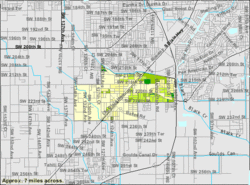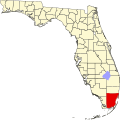2020 census
As of the 2020 United States census, there were 11,446 people, 3,336 households, and 2,371 families residing in the CDP. [11]
As of the 2010 United States census, there were 10,103 people, 2,453 households, and 1,925 families residing in the CDP. [12]
2000 census
As of 2000, there were 7,453 people, 2,214 households, and 1,762 families residing in the CDP. The population density was 972.2 people/km2 (2,518 people/sq mi). There were 2,367 housing units at an average density of 308.8 units/km2 (800 units/sq mi). The racial makeup of the CDP was 15.22% White (4.9% were Non-Hispanic White), [13] 78.13% African American, 0.17% Native American, 0.54% Asian, 0.01% Pacific Islander, 3.48% from other races, and 2.46% from two or more races. Hispanic or Latino of any race were 16.36% of the population.
As of 2000, there were 2,214 households out of which 45.5% had children under the age of 18 living with them, 31.5% were married couples living together, 41.2% had a female householder with no husband present, and 20.4% were non-families. 15.7% of all households were made up of individuals and 5.2% had someone living alone who was 65 years of age or older. The average household size was 3.37 and the average family size was 3.72.
In 2000, in the CDP the population was spread out with 38.4% under the age of 18, 10.9% from 18 to 24, 25.1% from 25 to 44, 16.3% from 45 to 64, and 9.2% who were 65 years of age or older. The median age was 26 years. For every 100 females there were 86.8 males. For every 100 females age 18 and over, there were 77.3 males.
In 2000, the median income for a household in the CDP was $19,633, and the median income for a family was $21,728. Males had a median income of $23,165 versus $20,017 for females. The per capita income for the CDP was $8,649. About 37.6% of families and 43.6% of the population were below the poverty line, including 56.6% of those under age 18 and 32.3% of those age 65 or over.
As of 2000, speakers of English as a first language accounted for 83.54% of residents, while Spanish made up 15.42%, and French Creole was at 1.02% of the population. [14]
As of 2000, Goulds had the eighty-fourth highest percentage of African-American and black residents in the US, with 78.10% of the populace. [15] It had the third highest percentage of Bahamian residents in the US, at 2.0% of the population, [16] and the sixty-ninth highest percentage of Cuban residents in the US, at 4.70% of its population. [17] It also had the thirty-second most Jamaicans in the US, at 4.10% (tied with Tamarac and Royal Palm Beach,) [18] while it had the fifty-fourth highest percentage of Haitians, at 2.70% of all residents (tied with Jewett City, Connecticut, Georgetown, Delaware and Elizabeth, NJ.) [19] Goulds' Nicaraguan community had the thirty-sixth highest percentage of residents, which was at 1.15% of the population. [20]


